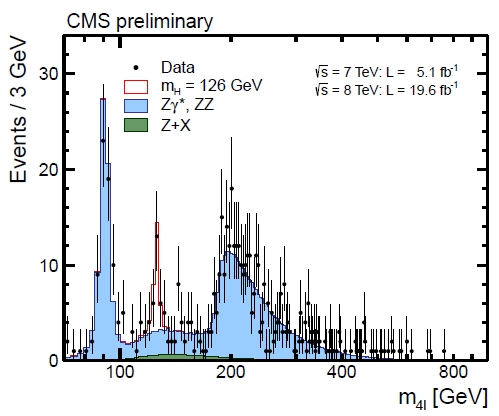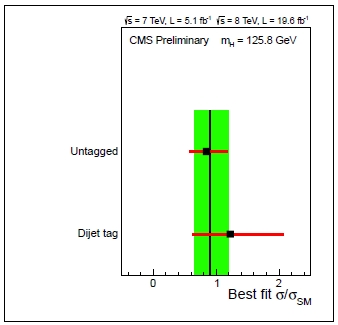Here I cannot possibly go through the large body of results that have been presented, of course. So for anything but two specific points I discuss below, it will have to suffice if I say that every measurement confirms the nature of the new object: a scalar particle with mass in the 125 GeV ballpark, with observed decays to photon pairs, Z boson pairs, W boson pairs, and tentative evidence for decays to b-quark pairs and tau-lepton pairs. Production modes and topology, as well as rates of decays into the various final states, are in line with the Standard Model predictions, except...
1- The question people have been most frequently asking since December 2011, when the first evidence of Higgs boson decays was presented at CERN, is of course whether the strength of the decay to photon pairs isn't in fact betraying a non-standard model nature of the discovered particle. Both ATLAS and CMS in fact produced cross section measurements with the diphoton decay mode which exceeded the Standard Model prediction. This excess stimulated a flurry of theoretical papers that attempted to paint scenarios where a neutral scalar has an enhanced coupling to photons.
The new diphoton result by ATLAS (slides here) does not change the picture significantly, although as mentioned above the added information on other decay modes that we have acquired makes the Standard Model hypothesis quite solid. In the diphoton mode ATLAS measures a cross section equal to 1.65 +0.34 -0.30 times the SM prediction, thus two standard deviations away from it. [By the way, ATLAS has produced a nice animated gif with the H->gamma gamma signal growing as data is collected, check it out here].
Funnily the ZZ signal from ATLAS also has a measured strength of 1.7 +0.5 -0.4, again a little less than two sigma above the SM. CMS, on the other hand, presents results on the ZZ mode where they see a signal with a strength of 0.91 +0.30 -0.24 times the SM expectation: thus the average of the ZZ intensities measured by the competing experiments is of 1.28+-0.21, quite in line with expectations.

Concerning that measurement: the mass distribution of CMS is such eye-candy that I cannot resist the temptation of pasting it here (see above), although you've certainly seen it elsewhere first. Notice in particular how CMS has, thanks to the high-acceptance of their lepton selection, a very large peak of Z->4-lepton events (the peak at 91 GeV). Then the Higgs peak at 125 GeV is very narrow, thanks to the excellent mass resolution of the experiment. This graph is a dream come true for those like me, who have been hoping to see something similar for the last twenty years...
 And on the right you can see the two separate determinations of the H->ZZ rate by CMS; the subsets refer to events where the two Z bosons appear alone, or with forward jets in addition, betraying in the latter case the production by vector-boson fusion processes.
And on the right you can see the two separate determinations of the H->ZZ rate by CMS; the subsets refer to events where the two Z bosons appear alone, or with forward jets in addition, betraying in the latter case the production by vector-boson fusion processes.2- Last fall ATLAS presented results for the Higgs boson mass measurement that evidenced some startling disagreement between the determination performed using the gamma-gamma final state and the determination performed using the four-lepton final state.
The difference was a 2.6 standard deviation effect, which to many is -in the absence of look-elsewhere effect corrections or dubious evaluations of systematic uncertainties- enough evidence to reject the null hypothesis. The null hypothesis, being of course the coincidence of Higgs boson masses in the two decay channels, is on the other hand a very tough one to reject: if one does reject it, the alternative one has to marry is the existence of two distinct particles, each decaying predominantly to one of the two bosonic final states.
Because of this "damned if you do, damned if you don't" situation, many of my colleagues think that ATLAS should have withheld the result, investigating the matter more carefully before making the measurements public. But I disagree ! A 2.6 sigma effect is a one-in-two-hundred thing, which does arise by chance now and then. And even assuming that indeed some systematic uncertainties (most likely, ones on the lepton or photon energy scales, which directly affect with a scale factor the mass measurements one way or the other) have been underestimated, what is the damage of publishing a preliminary result (i.e. not in a scientific journal, but just at a conference) while more work is being carried out ?
Indeed, one can demonstrate that the selective removal from publication path of results based on how much these depart from prior expectations of the experimenters is a practice that changes the coverage properties of the error bars of the results that do get published. It is just as if by only showing your best pictures you try to prove that you are more photogenic than you actually are, creating a false impression. By insisting that they do not publish discrepant results, experiments end up messing up --underestimating or overestimating-- the error bars of those experiments they do publish. The effect goes in both directions depending on whether the true value of the measured quantity is far from expectations or close to them.
Now, what is the situation of this "double peak" in the full dataset presented by ATLAS this week? Things appear to have gone in the right direction, but only very slightly so: by throwing more data in, and by (I assume) re-checking and re-optimizing their energy scale measurements, the ATLAS folks now present the following two measurements:
ATLAS Diphoton mode: M(H) = 126.8 +- 0.7 GeV (3/2013; old one was 126.5 GeV)
ATLAS Four-lepton mode: M(H) = 124.3 +0.8 -0.6 GeV (3/2013; old one 123.5 GeV).
If one assumes the errors of these two determinations as fully uncorrelated (a good approximation), one may compute that the two results are discrepant by 2.5 +- 1.05 GeV: this is still a 2.4 standard deviation effect.
It is then quite appropriate to take a step back and consider that if this particle is the same that CMS also studies, one can take profit of the CMS measurements to see the matter more clearly. Let us then see what CMS measures:
CMS Diphoton mode: M(H) = N/A (result will be out shortly)
CMS Four-lepton mode: M(H) = 125.8 +-0.5 GeV (new measurement, 3/2013)
We are bound (for a few more days!) to do without the diphoton mass measurement of CMS, unfortunately. But already we can combine the two H->ZZ->4l results, finding:
Diphoton mode (ATLAS only): M(H) = 126.8 +- 0.7 GeV
Four-lepton mode (ATLAS+CMS, unofficial): M(H) = 125.3 +- 0.4 GeV
Bear in mind that the one above is a poor-man combination, performed without accounting for correlations (they should be small anyways) and by putting together statistical and systematic uncertainties. Still, we learn something by comparing the two numbers. They are quite a bit less discrepant if we use the full information in our hands: they differ by less than two standard deviations now.
What I am getting at, I guess, is that the excitement for the possibility of having discovered _two_ new particles should dampen significantly. It is not time for an early claim of my two $100 bets -the ones that two readers of this blog accepted a couple of months ago, on the ATLAS peaks corresponding or not to two distinct states- but we are getting there!




Comments